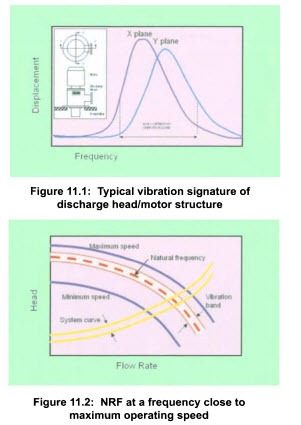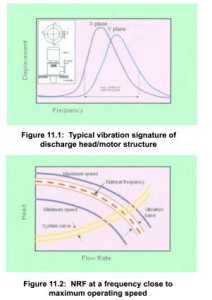Resonant vibrations in vertical pumps
Variable speed vertical pumps are more likely than horizontal machines to exhibit operational zones of excessive vibration, because their lower natural frequencies are more likely to coincide with running speeds. Some specific guidance is therefore provided in this Chapter.
Small, vertical close-coupled and multistage pumps do not normally show this type of problem.
Most manufacturers of large vertical pumps and motors have in-house technology to determine the natural reed frequency (NRF) and will do this job by job on engineered vertical pump sets.
It is normal practice to design the driver support (discharge head) of vertical pumps, such that the NRF of the pump/motor unit has a separation margin of 20% above the maximum operating r/min, or 20% below the mini mum operating r/min. The motor NRF is needed to make this calculation. If this criterion is not satisfied it may be possible to select a pump with a different synchronous full speed; as an example changing from six pole to four pole or six pole to eight pole, to achieve the desired non-resonance band of operation. The specifying engineer should consult with the pump manufacturer prior to specifying motor synchronous speed and the pump speed ranges, when the vertical pump is driven by a variable speed driver.
Another way of avoiding the pump running at the NRF is to lock out the problem speed zone of operation on the variable frequency drive (VFD) control. The pump may have different NRFs in the x andy directions, so it is necessary to avoid a band of speeds as shown in Figure 11.1. This may limit the pump’s useful range of operation: therefore, it is usually preferable if possible to change the pump/motor structural stiffness to move the resonance band away from the desired operating zone.
The influence of the foundation stiffness on the NRF must be considered. It is desirable to have a foundation that will create less than 5% of the total deflection of the pump/driver structural elements. Typically a reinforced concrete foundation will achieve this.
If the NRF is close to the maximum range of operating speed (Figure 11.2), the unit usually may be stiffened. However, there is a limit to the pump manufacturer’s ability to stiffen the unit’s structure. Procuring a stiffer vertical motor may not be feasible. However, by providing a stiffer motor support (fabricated discharge head) it may be possible to raise the pump’s NRF above maximum operating speed.
If the NRF is close to the minimum range of operating speed (Figure 11.3), the unit may be made more flexible. This will lower the natural frequency below the operating range. During start-up and shutdown, the unit will pass through its natural frequency and vibration may occur. However, this vibration should not be damaging due to its very short duration of time.

